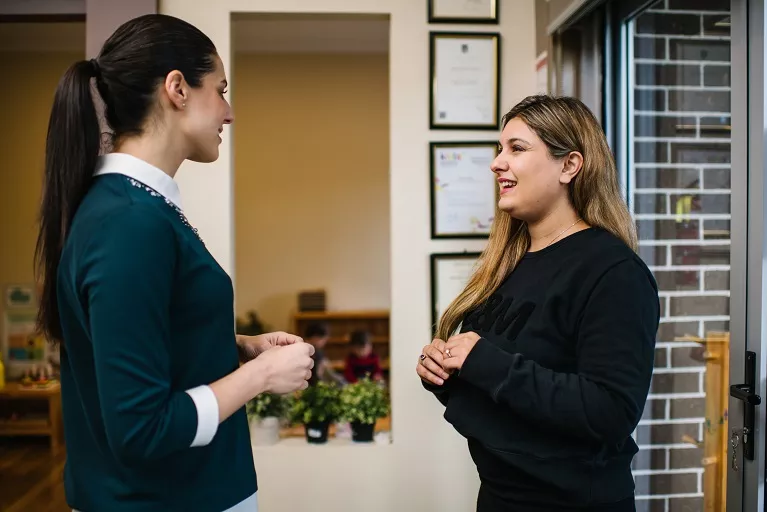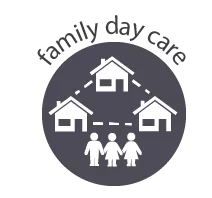Standard 1.3 Assessment and planning – Case study 2
- Home
- Quality ratings
- Exceeding NQS
- Quality Area 1 – Educational program and practice
- Standard 1.3 Assessment and planning – Case study 2
Educators and co-ordinators take a planned and reflective approach to implementing the program for each child.


This This family day care service is situated in a coastal city and currently caters for children under school age only. The service’s philosophy prioritises building strong and respectful relationships as the foundation for getting to know each child and their family. The service team believe that getting to know the children and families well, right from the start, is key to developing and implementing educational programs for all children.
A feature of the service is their comprehensive enrolment and orientation process for families and children, which gathers detailed information from families about their child’s knowledge, strengths, culture, curiosities, capabilities, and interests. As part of the enrolment process, the service invites families to attend a meeting with the educator. During this meeting, they share information about their environment, program and philosophy and gather extensive information about each child, including families’ goals for their child and expectations about the educational program.
Educators value the information that families are willing to share with them as a critical starting point in getting to know new children and to assist in their program planning. They explain to families how the information that they share with them is combined with other observations they gather about their child as they participate in the program. All this information is analysed to set individual learning goals and to plan and implement experiences to support each child’s full participation in the program. Further reflections on the child’s progress and participation in the program are used to complete the assessment and planning cycle that is used by all educators.
Conversations with families also focus on the varied ways the service and individual educators can share and exchange information about the children’s learning, wellbeing, and development. This may include regular posts on the communication app that the service uses, as well as informal conversations, emails, and telephone calls. Coordination unit staff support educators and families to hold meetings at times that are suitable for both parties and that enable quality discussions to be held. Coordination unit staff also proactively maintain regular contact with families and send regular surveys to gather families' feedback on the program.
The service is equally committed to building strong and respectful relationships with their educators. Integral to this approach is the provision of support for educators’ ongoing learning and development as part of the service’s vision for quality improvement. This includes holding regular coordination unit/educator meetings, and providing targeted, ongoing professional learning opportunities for all educators. These opportunities also strengthen educators’ professional networks, creating a culture of engagement and inquiry. This, in turn, helps to ensure that all educators have opportunities to contribute to discussion and debates in a way that respects and values different views and perspectives.
The educational leader and service coordinators regularly engage in critical reflection to identify areas where further quality improvements can be supported across the service. A recent reflection amongst coordinators prompted discussions on how they could further support educators to use all the steps of the planning cycle. There was agreement that it was important to support educators to use methods that best suit their individual approach, expertise, and style but to ensure that each step of the cycle was visible and completed. There were, however, varying perspectives about where and how to start. Some coordinators wanted to start with processes for gathering meaningful information about children’s learning, development, and wellbeing, however others were keen to go back to the ‘why’ of assessment and planning. For them, this approach offered important opportunities for educators to reflect on practice and share their different ideas and perspectives, including what influences their current approach. After much discussion and debate, the coordinators agreed to revisit the ‘why’ and then explore each phase of the planning cycle, using reflective questions to inform the discussion.
To begin exploring the first step of the planning cycle, at a coordination unit/educator meeting, the educational leader encouraged educators to reflect on how they collect information about each child in order to assess their learning and plan for future learning. Educators were asked to share their individual approaches to documenting children’s thinking and learning. As part of this discussion, the educational leader also asked a series of reflective questions to inform the discussion. Questions included: How does the information gathered add value to outcomes for the children? How do I ensure that my observations are meaningful and more than just a description of what children are doing or have done? What formats do I use? Do they capture the essential information?
Some educators who were new to the service were initially reluctant to share what they were doing with each other. They were reassured by the educational leader who explained that there isn’t just one right way to go about this, and that there are a range of ways to collect meaningful information about children’s learning. The educational leader also highlighted the opportunities these discussions provided to share ideas and insights about their various approaches to assessment and planning, while also ensuring it continues to connect to the service’s philosophy and approved learning frameworks.
The educators discussed the various methods they were using to collect data and make learning visible for children and families. These included using tablets to take photos, videos, and notes throughout the day and/or recording written notes on sticky-notes or in notebooks. Some educators shared that they were finding it more useful to use voice recording or voice-to-text apps on their phones, as this helped them to quickly capture their thoughts and notes at any time. At subsequent meetings they have explored each of the other steps of the planning cycle including analysing, planning, implementing, and reflecting on children’s learning, to ensure that the programs provided for the children are authentic, meaningful and relevant.
As part of the meetings that the coordination unit arrange, there is a long-standing agenda item called ‘Be-Dazzled’. This provides an opportunity for educators to share something from their own family day care residence that they think others might find interesting or inspiring. As part of the discussion about their individual approaches to planning and implementing the program for each child, one educator shared a recent example about two siblings who attend their residence. The children had used sheets and rugs to create a makeshift ‘tent’ in the playroom, an activity that they repeated over the next couple of days, with lots of discussion about what they did when they went camping.
The educator told the children’s family about their play and shared some of the photos taken of them ‘camping’. The family responded by telling the educator that they had recently camped in the nearby national park and that the children had, for the first time, slept in a tent and had a campfire. They shared some of the photos they had taken on the camping trip with the educator and offered to bring their tent to the educator’s home so that it could be set up in the backyard.
The children were delighted with this idea and eagerly helped their family to bring in the tent and their sleeping bags when they arrived the next morning. With assistance from the educator, the siblings showed the other children how to put up the tent and they spent most of the morning playing in it.
Thinking back to conversations at recent coordination unit/educator meetings, the educator reflected on how she could engage the children in analysing their own learning as well as what provisions they might make available to further extend on the children’s interests. At their suggestion, the educator also added loose parts to the sandpit as a provocation, including sticks, bark, rocks, and pebbles. One of the siblings demonstrated to another child how to make a campfire, forming a circle with the rocks, and using the sticks and twigs to form a pretend fire. The children excitedly engaged in ‘cooking’, using leaves as ’marshmallows’ and talking about other favourite foods that they had when they were camping.
At the meeting, the educator shared that during that day and over subsequent days as the interest continued, the children’s engagement in role playing various camping scenarios was documented, using sequences of photographs and transcripts of children’s conversations. The contributions from the family about their children’s camping experience were included. The educator told the other educators that an analysis of what had been learned about the children’s thinking and learning was documented and links made to related key components of the learning outcomes from the approved learning frameworks. Plans for further teaching and learning to build on and extend the children’s interests were documented and included in the program.
The educator also described making notes in the reflection journal, reflecting on the experience using the principles and pedagogical practices of the approved learning frameworks. As part of the critical reflection and ongoing professional learning principle, the educator considered how children could be supported and encouraged to reflect on and document their own experiences in the program. A note was included in the reflection journal as a reminder to discuss this with the educational leader when they next spoke or met. The educator also reflected on the Early Years Learning Framework V2.0 practices of ’Responsiveness to children’ and ‘Play-based learning and intentionality’ which helped to identify what worked well and opportunities for further improvement.
Photos of the children’s role play connected to the camping theme were shared with all families using a looping slideshow on their tablet, which is on show at the end of each day for families to view when they collect their children. These images generated much discussion with other families, many of whom were frequent visitors to the national park for walks, swims, picnics, and camping.
The educator explained that this led to further reflections on how the national park might be better utilised in the educational program to broaden children’s connection with and sense of belonging to their local community. Other educators were also interested in exploring this further so it was decided that it would be put on the agenda for the next educator meeting. Prior to the meeting, the educational leader sourced information from the national park’s visitor centre about possible walking tracks, available facilities and any sites of interest that would be suitable for the children’s age groups. This was discussed with great interest and enthusiasm by the educators at the meeting.
As an outcome of the meeting, educators volunteered to take on various tasks to complete before the next meeting. One educator, for example, offered to undertake a physical check and risk-benefit assessment of a visit to the national park. Another educator was keen to explore whether there were any local cultural walks that might be suitable for the children as an added opportunity to learn more about local Aboriginal and Torres Strait histories and cultures.
At further meetings, the educator shared that the children who originally instigated the interest in camping continued to engage in role play, as did their peers. As a result, some children are now bringing in photos of their visits to the national park to share with the educator and their peers. The children’s attention more recently has turned to cooking meals on the campfire, with damper being a clear favourite. The educator described how the development of the play had been captured, and the resulting learning, in children’s learning and development records. The next time the family have an opportunity to view their children’s records, the educator hopes that they will be excited to see how their camping weekend away sparked some wonderful learning experiences for all children.
* To create a print friendly version of this case study, please click ‘print’ in the red menu bar.